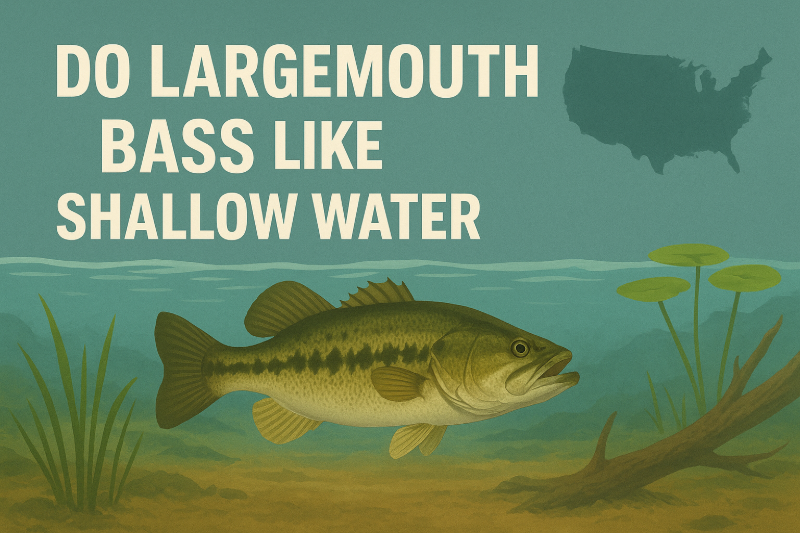
If you’ve ever stood on a lake shore and wondered, do largemouth bass like shallow water, the answer is yes. But it depends on the time of year, water temperature, and what the bass are feeding on. Shallow water plays a major role in a largemouth’s life cycle. From feeding to spawning, bass often move in and out of the shallows for specific reasons. Knowing when and why they’re there can help you catch more fish.
Why Largemouth Bass Like Shallow Water
Largemouth bass are opportunistic predators. They use shallow water as a place to feed, hide, and sometimes spawn. The shallows are full of life — baitfish, crawfish, frogs, and insects all thrive there. With so much food available, it makes perfect sense why largemouth bass like shallow water when conditions are right.
Bass are also ambush hunters. They take advantage of structure such as grass lines, laydowns, docks, and rocks to surprise prey. Shallow areas offer plenty of these hiding spots. When water clarity is stained or slightly murky, bass feel even more comfortable moving shallow since it provides cover and shade.
Water temperature is another factor. Largemouth bass prefer water in the range of 60 to 75 degrees Fahrenheit. During spring and fall, when shallower areas warm or cool quicker than deeper water, bass head there to feed aggressively. In the heat of summer or during cold winter months, they usually retreat to deeper zones where temperatures are more stable.
What Largemouth Bass Eat in Shallow Water
Understanding what largemouth bass eat in shallow water can help you choose the right bait and improve your success. In spring and early summer, bass often feed on bluegill, shad, frogs, and crawfish. As the water warms, these food sources move shallow, and the bass follow.
If you fish around vegetation, topwater frogs or buzzing baits can imitate real prey perfectly. Around rocks and sandy bottoms, crawfish-colored crankbaits or soft plastics often produce bites. When baitfish like shad or minnows are schooling near the surface, bass chase them into shallower pockets — that’s when topwater baits shine.
Bass also use shallow areas to feed during low-light conditions such as early morning, late evening, or cloudy days. The reduced light makes them feel secure while hunting.
When Largemouth Bass Like Shallow Water the Most
The best time to find largemouth bass in shallow water changes depending on the region and season.
In the South:
Bass often move shallow early in the year, sometimes as soon as late February or March, when water temperatures begin climbing into the 60s. This is prime spawning season. Shallow coves, flats, and protected pockets with sandy or gravel bottoms attract bass looking to make beds.
In the Midwest and Northeast:
Water warms more slowly, so bass usually move shallow in late April through May. This pre-spawn and spawning period is one of the most productive times to fish shallow. Bass are active, territorial, and feeding heavily.
In the West:
Reservoirs and clear lakes often see bass moving shallow in early spring, but they may stay near cover such as submerged brush or rock piles to avoid bright sunlight. During fall, cooling temperatures pull baitfish shallow again, and bass follow for one last feeding spree before winter.
During summer, largemouth may still use shallow water early and late in the day, but once the sun gets high, most move deeper to find cooler, oxygen-rich areas.
How to Catch Largemouth Bass in Shallow Water
If you know that largemouth bass like shallow water under certain conditions, you can adjust your tactics to catch them. Cast along grass lines, stumps, and shaded areas where bass hide. Use soft plastics, spinnerbaits, or topwater frogs depending on what they’re feeding on. Stay quiet and make long casts — shallow bass can be spooky in clear water.
Always pay attention to temperature and season. In spring and fall, focus shallow. In mid-summer, look for shaded shallows or spots near deeper drop-offs where bass can move up and down easily.
Final Thoughts on Why Largemouth Bass Like Shallow Water
So, do largemouth bass like shallow water? Absolutely — especially when the water temperature, food supply, and cover all line up. Whether they’re feeding, spawning, or hunting baitfish, shallow zones offer everything they need to thrive. Learning these patterns and paying attention to seasonal changes will not only make you a better angler but help you understand one of fishing’s most exciting behaviors: the shallow-water strike of a largemouth bass.
